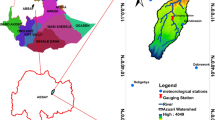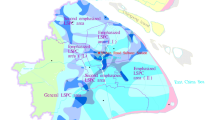Abstract
Based on the monitoring data from 13 typical monitoring sites along the Qinghai–Tibet Highway, the degradation characteristics of the permafrost under asphalt pavement and natural ground surface were analyzed with considerations of climate warming and engineering disturbance. Results indicated that the mean annual thawing indexes (MATI) and mean annual freezing indexes (MAFI) of asphalt pavement ranged from 895 to 2,540 °C days and from 290 to 1,097 °C days, respectively, while the MATI and MAFI of natural ground ranged from 144 to 1,550 °C days and from 127 to 1,544 °C days, respectively. In warm seasons, average temperatures of asphalt pavement were 0.76–8.58 °C higher than that of natural ground, while in cold seasons, average temperatures of asphalt pavement were 0.22–4.19 °C lower than that of natural ground. Both natural permafrost table and artificial permafrost table were continuously declining through 1995–2011. Under the effect of climate warming, the active layer thickness (ALT) increased about 0.44 m, with an average increasing rate of 3.42 cm a−1 in cold permafrost regions [the mean annual ground temperature lower than −1.0 °C (MAGT < −1.0 °C)], while in warm permafrost regions (MAGT > −1.0 °C), the ALT increased about 0.68 m, with an average increasing rate of 5.72 cm a−1. Under the effect of engineering disturbance, the ALT increased 1.38 m in cold permafrost regions, with an average increasing rate of 12.28 cm a−1, while in warm permafrost regions, the ALT increased 1.32 m, with an average increasing rate of 11.18 cm a−1. Meanwhile, changes in permafrost temperature under asphalt pavement were different from that under natural ground. The warming rate in permafrost under asphalt pavement at 6, 10 and 15 m depths was 0.024, 0.022 and 0.02 °C a−1, respectively, while the three values under natural ground were 0.016, 0.013 and 0.013 °C a−1. From these results above, it can be concluded that influences from climate warming on permafrost degradation in warm permafrost region were greater than that in cold permafrost region, and influences from engineering disturbance on permafrost degradation in warm permafrost region were less than that in cold permafrost region.















Similar content being viewed by others
References
Cheng G, Jin H (2013) Groundwater in the permafrost regions on the Qinghai–Tibet Plateau and its changes. Hydrogeol Eng Geol 40:1–11 (in Chinese)
Cheng G, Wu T (2007) Responses of permafrost to climate change and their environmental significance, Qinghai–Tibet Plateau. J Geophys Res 112(F2). doi:10.1029/2006JF000631
Frauenfeld OW, Zhang T, Mccreight JL (2007) Northern Hemisphere freezing/thawing index variations over the twentieth century. Int J Climatol 27(1):47–63. doi:10.1002/joc.1372
Harris C, Vonder Mühllb D, Isaksen K et al (2003) Warming permafrost in European mountains. Glob Planet Change 39:215–225. doi:10.1016/j.gloplacha.2003.04.001
IPCC (2013) Working group I contribution to the IPCC fifth assessment report (AR5). Climate change 2013: the physical science basis. Final Draft Underlying Scientific-Technical Assessment [R/OL]
Jiang F, Hu R, Li Z (2008) Variations and trends of the freezing and thawing index along the Qinghai–Xizang Railway for 1966–2004. J Geogr Sci 18:3–16. doi:10.1007/s11442-008-0003-y
Jin H, Zhao L, Wang S, et al (2006) Ground temperature characteristics and degradation style about permafrost along the Qinghai-Tibet Highway. Sci China Ser D Earth Sci 36(11):1009–1019 (in Chinese)
King L, Herza T, Hartmanna H et al (2006) The PACE monitoring strategy: a concept for permafrost research in Qinghai–Tibet. Quat Int 154(155):149–157
Li S, Wu T (2005) The relationship between air temperature and ground temperature in the Tibet Plateau. J Glaciol Geocryol 27:627–631 (in Chinese)
Li R, Zhao L, Ding Y et al (2012) Temperature and spatial variations of the active layer along the Qinghai-Tibet Highway in a permafrost region. Chin Sci Bull 57(30):2864–2871
Liu X, Chen B (2000) Climatic warming in the Tibetan Plateau during recent decades. Int J Climatol 20:1729–1742
Liu S, Zhang J (2012) Review on physic-mechanical properties of warm frozen soil. J Glaciol Geocryol 34:120–129 (in Chinese)
Ma W, Mu Y, Li G et al (2013) Responses of embankment thermal regime to engineering activities and climate change along the Qinghai–Tibet Railway. Sci Sin Terrae 43:478–489 (in Chinese)
Marcott SA, Shakun JD, Clark PU et al (2013) A reconstruction of regional and global temperature for the past 11,300 years. Science 339:1198–1201. doi:10.1126/science.1228026
Nan Z, Li S, Cheng G (2005) Prediction of permafrost distribution on Qinghai–Tibet Plateau in the next 50 and 100 years. Sci China Ser D Earth Sci 48:797–804
Osterkamp TE (2007) Characteristics of the recent warming of permafrost in Alaska. J Geophys Res Earth Surf (2003–2012), 112:F02S02. doi:10.1029/2006JF000578
Sheng Y, Zhang J, Liu Y et al (2001) Thermal regime in the embankment of Qinghai–Tibet Highway in permafrost regions. Cold Reg Sci Technol 35:35–44
Wang P, Tang G, Cao L et al (2012) Surface air temperature variability and its relationship with altitude and latitude over the Tibet Plateau in 1981–2010. Progress Inquisitiones DE Mutatione Climatis 8:313–319 (in Chinese)
World Meteorological Organization (2013) The global climate 2001–2010: a decade of climate extremes-summary report, WMO-No. 1103
Wu Q, Niu F (2013) Permafrost changes and engineering stability in Qinghai–Xizang Plateau. Chin Sci Bull 58. doi:10.1007/s11434-012-5587-z
Wu Q, Zhang T (2010) Changes in active layer thickness over the Qinghai–Tibetan Plateau from 1995 to 2007. J Geophys Res Atmos 115:D09107. doi:10.1029/2009JD012974
Wu Q, Shi B, Liu Y (2003) Study on interaction of permafrost and highway along the Qinghai–Xizang Highway. Sci China (Ser D) 46:97–105
Wu Q, Cheng G, Ma W et al (2006) Technical approaches on permafrost thermal stability for Qinghai–Tibet Railroad construction. Int J Geomech Geoengin 1:119–127
Wu Q, Dong X, Liu Y (2007a) Responses of permafrost on the Qinghai–Tibet Plateau, China, to climate change and engineering construction special section. Arct Antaret Alp Res 39:682–687
Wu Q, Liu Y, Yu H (2007b) Analysis of the variation of permafrost under ordinary embankment along the Qinghai–Tibet Railway. J Glaciol Geocryol 29:960–968 (in Chinese)
Wu Q, Zhang T, Liu Y (2010a) Permafrost temperatures and thickness on the Qinghai–Tibet Plateau. Glob Planet Chang 72:32–38
Wu Q, Zhang Z, Liu Y (2010b) Long-term thermal effect of asphalt pavement on permafrost under embankment. Cold Reg Sci Technol 60:221–229
Wu Q, Zhang T, Liu Y (2011) Thermal state of the active layer and permafrost along the Qinghai–Xizang (Tibet) Railway from 2006 to 2010. Cryosphere Discuss 5:2465–2481
Yin Y, Wu S, Zhao D et al (2012) Impact of climate on actual evapotranspiration on the Tibetan Plateau during 1981–2010. Acta Geogr Sin 67:1471–1481 (in Chinese)
Zhao L, Wu Q, Marchenko SS et al (2010) Thermal state of permafrost and active layer in Central Asia during the International Polar Year. Permafr Periglac Process 21:198–207
Zimov SA, Schuur EA, Chapin FS (2006) Permafrost and the global carbon budget. Science 312:1612–1613
Acknowledgments
This work was support by the National Key Basic Research Program of China (973 Program) (No. 2012CB026106), National Key Technology Support Program (No. 2014BAG05B01), West Light Program for Talent Cultivation of Chinese Academy of Sciences (for doctor Y. Mu).
Author information
Authors and Affiliations
Corresponding author
Rights and permissions
About this article
Cite this article
Peng, H., Ma, W., Mu, Yh. et al. Degradation characteristics of permafrost under the effect of climate warming and engineering disturbance along the Qinghai–Tibet Highway. Nat Hazards 75, 2589–2605 (2015). https://doi.org/10.1007/s11069-014-1444-5
Received:
Accepted:
Published:
Issue Date:
DOI: https://doi.org/10.1007/s11069-014-1444-5




